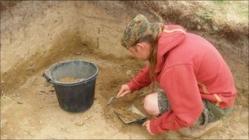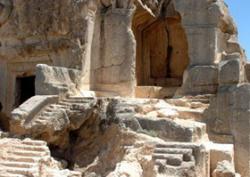- 15 AOÛT
- INDI-UNI : 
PRE-INSCRIPTION : 15 Juin – 31 Août
PRE-REGISTRATION: June 15th - August 31st
- SUISSE – Windisch – Un aqueduc de près de 2000 ans découvert. Les neuf piliers datent probablement du 1er siècle de notre ère. Ils sont situés au sud des vestiges du camp de légionnaires de Vindonissa. Au même endroit, les scientifiques ont mis au jour plusieurs routes romaines bien conservées, indique l'office argovien d'archéologie lundi. De la vaisselle, des bijoux, des amphores et de la monnaie font également partie des objets retrouvés.
http://www.20min.ch/ro/news/suisse/story/Un-aqueduc-de-pres-de-2000-ans-decouvert-21565897
- ISRAEL - Horvat Tarbenet - Israeli archaeologists excavating in the Jezreel Valley uncovered a 1,800-year-old marble statue of a naked Hercules leaning on a club and showing off the skin of a Nemean lion. “This is a rare discovery,” Israel Antiquities Authority’s Walid Atrash said in an e-mailed statement. He said the statue was about half a meter tall, made of smooth, white marble and “of exceptional artistic quality.” The statue was found in Horvat Tarbenet as part of an excavation before a new railway that will link northern Israeli communities of Haifa, Afula and Beit Shean, the Antiquities Authority said.
http://www.bloomberg.com/news/2011-08-15/ancient-marble-statue-of-naked-hercules-found-in-jezreel-valley.html
- FRANCE – Tours - La ville de Tours est née à l'époque gallo-romaine, au début de notre ère. Les vestiges de cette période dorment sous terre, dans le centre historique. La récente polémique sur les fouilles préventives menées rue Nationale en marge du chantier du tramway rappelle, s'il en était besoin, les origines gallo-romaines de la ville de Tours. Depuis 1968, plusieurs campagnes de fouilles ont été menées, à l'occasion de différents programmes d'aménagement et ont permis de situer quelques édifices, même si cette ville gallo-romaine a laissé, notent les archéologues, « peu d'héritage dans le paysage urbain. » Il y a 2.000 ans, la cité, baptisée « Caesarodunum » - ce qui signifiait « colline de César » - est ensuite devenue « Civitas Turonorum », c'est-à-dire « la cité de Turons », du nom des habitants de la région. Elle s'étendait sur une cinquantaine d'hectares, possédait un pont sur la Loire et des monuments publics (thermes, temples, amphithéâtre, etc.).Selon les chercheurs, le forum, véritable coeur de la ville, se situait probablement « à l'est de la rue Nationale », au débouché du pont antique. De futures campagnes de fouilles permettront peut-être de le préciser. Il reste, d'ailleurs, beaucoup à apprendre sur le passé de Tours. Par exemple, jusqu'à présent, aucune trace n'a été décelée d'une période intermédiaire qui va de la fin de l'occupation gauloise d'un site situé à l'emplacement de l'actuel hôpital Clocheville à l'essor de la cité antique. Un « trou » de deux siècles environ, avant le début de notre ère. L'enquête continue !
http://www.lanouvellerepublique.fr/LOISIRS/Patrimoine-tourisme/Vestiges-et-temoignages-de-nos-ancetres-les-Turons
- IRLANDE –  x Gunwalloe on the Lizard - Archaeologists have been unearthing the secrets of a Cornish cliff face which is in danger of being destroyed. Gunwalloe on the Lizard is thought to have been the site of an early medieval settlement and home for Saint Winwaloe from Brittany. But the site is eroded by winter storms every year. Historic documents suggest that Saint Winwaloe may have visited the site in the 6th Century AD and possibly lived in a hermitage in the cliffs behind the current church. It is thought that he came to convert the local Cornish people to Christianity.
x Gunwalloe on the Lizard - Archaeologists have been unearthing the secrets of a Cornish cliff face which is in danger of being destroyed. Gunwalloe on the Lizard is thought to have been the site of an early medieval settlement and home for Saint Winwaloe from Brittany. But the site is eroded by winter storms every year. Historic documents suggest that Saint Winwaloe may have visited the site in the 6th Century AD and possibly lived in a hermitage in the cliffs behind the current church. It is thought that he came to convert the local Cornish people to Christianity.
http://www.bbc.co.uk/news/uk-england-cornwall-14512930
- SYRIE –  Tal al-Humira - Director of Damascus Countryside Antiquities Department Mahmud Hammoud said that the national archeological mission working at Tal al-Humira archeological site in Deir Attiya in Damascus suburb. Mud brick houses dating back to the late Jomon period (from about 2000 to 1000 BC) were discovered at the site and also the national archeological mission unearthed stamps, pottery vessels and stone basins and ovens of different sizes in addition to Basalt instruments and vessels. Mr. Hammoud added that importance of Tal Humira site emerges from witnessing the prosperity of Aramaic Kingdoms, in addition to the Assyrian kings' attacks on Damascus Kingdom. Hammoud indicated that the archeological mission also unearthed an inscribed pottery fragment with Aramaic letters which indicates the possibility of finding a temple at the site.
Tal al-Humira - Director of Damascus Countryside Antiquities Department Mahmud Hammoud said that the national archeological mission working at Tal al-Humira archeological site in Deir Attiya in Damascus suburb. Mud brick houses dating back to the late Jomon period (from about 2000 to 1000 BC) were discovered at the site and also the national archeological mission unearthed stamps, pottery vessels and stone basins and ovens of different sizes in addition to Basalt instruments and vessels. Mr. Hammoud added that importance of Tal Humira site emerges from witnessing the prosperity of Aramaic Kingdoms, in addition to the Assyrian kings' attacks on Damascus Kingdom. Hammoud indicated that the archeological mission also unearthed an inscribed pottery fragment with Aramaic letters which indicates the possibility of finding a temple at the site.
http://www.dp-news.com/en/detail.aspx?articleid=92604
- CHINE – Suzhou - A large group of ancient tombs from six different dynasties were discovered at Huqiu County of Suzhou city in Jiangsu province. The earliest of the tombs dates back to the early part of the Eastern Han dynasty, and the tombs are from different eras that overlap with one another, which present a spectacular scene. It is a rare find in the archaeological history of Suzhou. Archaeologists are now excavating the tombs have already unearthed a wide variety of precious cultural relics, including pottery, porcelain, bronze mirror and gold hairpins.The recently discovered massive tomb group is located to the southwest of Huqiu scenic area. The place is undergoing a comprehensive improvement project. The natives call this area the Tomb of the Family Song. An archaeologist said that the of Family Song's Tomb remains were a big mound of 2,000 square meters, with a height of 6 meters at the highest point, and they are about 1,000 meters from the Huqiu scenic area.
The ancient tombs group crosses six ancient eras: Eastern Han, the Six Dynasties, Tang, Song, Ming and Qing. At present, 41 tombs have been excavated, most of which were from the Ming and Qing dynasties. According to the epitaphs, most of them are family cemeteries and the earliest tombs can date back to the Song Dynasty. Most coffins have completely rotted away. Only a Qing dynasty coffin remains because it is well painted and sealed and is relatively new. But it is so fragile that it can crumble at a touch. The archaeologist Zhang Tiejun said all these 41 excavated graves were of small and medium size. One of the largest among them was the Tomb of the Family Mao, which was designed and constructed by his son, a local elite, as he served as the vice minister of the ministry of personnel of the imperial government at that time. The reporter has learned from local residents that this group of ancient tombs was a once a large mound that was higher than the two-storey buildings nearby. Before the excavation, the mound was covered with weeds and trees, and some local people grew vegetables on it. Zhang said the current archaeological excavation is being carried out in an orderly manner.
http://english.peopledaily.com.cn/90882/7568198.html
- IRLANDE – Trim - A group of international archaeology students are working together to reveal the secrets of Trim, Co Meath, on what was once wasteland used for illegal dumping. They are on lands where in the 13th century the Dominicans built the Black Friary. The friary was an imposing building and is a short distance from Trim Castle, which was one of the locations used in the Mel Gibson movie Braveheart . Trim was once the capital of the lordship of Meath, which was second only to Dublin as the wealthiest holding in Ireland at the time. It was home to an annual market and people travelled from France, Germany and Belgium to attend it. “This was a busy town and there was a constant bustle and activity here for a couple of hundred years,” explained the school’s academic director, Finola O’Carroll. The Trim digs have recently uncovered a number of skeletons. After examining one skull dating from about 1540, an American graduate was able to decipher some of the secrets of its owner. “Based on the tooth wear, I would say this chap was somewhere between 40 and 50 years old when he died. He had arthritis and I also think he had TB,” explained Siobhán Swidersky (35), from Minnesota, US. The Black Friary site is owned by Trim Town Council and Ms O’Carroll said the work would continue until all the secrets had been uncovered.
http://www.irishtimes.com/newspaper/ireland/2011/0815/1224302451232.html